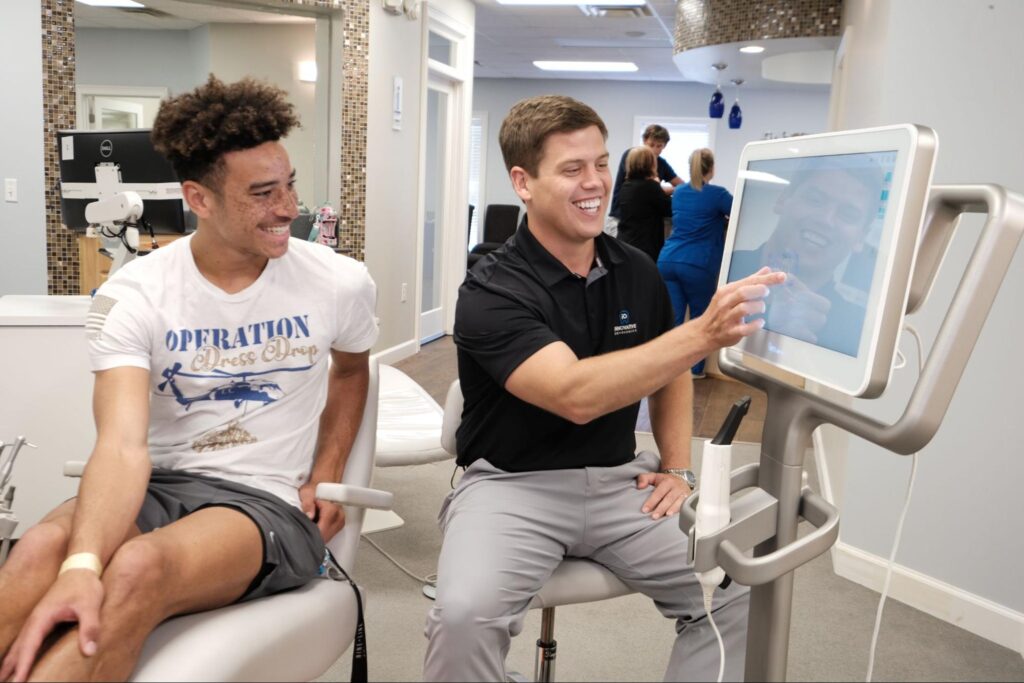When you’re committing to a process like orthodontic treatment, it makes perfect sense that you’ll want an idea of how long the treatment will take. Innovative Orthodonticsbelieves in setting clear expectations for everything from financingto treatment duration!
Estimating Treatment Time
Orthodontic treatmentis never one-size-fits-all by any means, and the same goes for how long it takes to complete. Here are a few points to consider when pondering your treatment duration:
- Severity of Alignment Issues– The more complex the case, the longer treatment may take. Mild cases with minor crowding or spacing might only take 6-12 months, while moderate to severe cases with significant misalignment, bite issues, or impacted teeth may take 18-30 months or longer.
- Age and Bone Development– Younger patients, especially children and teens, often experience faster tooth movement since their jaws and bones are still growing. Adult treatment may take slightly longer due to denser bone structure.
- Treatment Type– Invisalign, clear braces, and metal braceseach work differently, which affects the length of your treatment.
- Complexity: For some patients, treatment begins and ends solely with teeth being aligned. For others, we might have to address misalignment with the jaw, for example, which can require additional appliances and intervention.
- Patient Compliance– Following our team’s guidelines for wearing aligners and elastics and maintaining good oral hygiene can speed up your progress.
Myths About Treatment Duration
Some patients might try to find creative ways to accelerate treatment, sometimes with methods that aren’t too reliable! In other cases, popular misconceptions about duration can cause confusion. Let’s set the record straight:
Myth: “If my friend’s treatment took a year, mine will too.”
Every orthodontic case is different! Treatment length depends on factors like tooth alignment, bite issues, jaw structure, and patient compliance. Even if two people get braces at the same exact time, their treatment lengths can vary significantly.
Myth: “I can stop wearing my elastics if my teeth look straight.”
Rubber bands (elastics) help correct bite issues, not just tooth alignment. Stopping early can lead to relapse, discomfort, or the need for longer treatment. Consistency is the basis of all orthodontic treatment!
Myth: “Braces will move all my teeth at the same time.”
Teeth move in stages, not all at once. Certain teeth need to shift first to create space for others to move into their corrected positions. This gradual process helps prevent damage to roots and gums.
Myth: “Braces will move my teeth into place, and I won’t need a retainer.”
The truth is, after braces or aligners, your teeth will naturally want to shift back to their original positions. Wearing a retaineras instructed is instrumental to maintaining results and preventing this manner of relapse.
Myth: “Fast braces or mail-order aligners will straighten my teeth just as well as traditional orthodontics.”
While some companies claim to offer fast, at-home straightening, remember that unsupervised treatment will often lead to incorrect tooth movement, bite problems, and other long-term damage. Professional orthodontic care like ours guarantees results you’ll be happy with without unwanted complications.
Staying on Track
Bear in mind that there are some practices that can help speed up treatment, many of which you can do simply by following the guidance of Dr. Watersand Dr. Clayton.
- Wear Aligners as Directed: If you have Invisalign, always wear them for 20-22 hours per day. Taking them out too often or not switching to the next set on time can extend treatment time, especially if it’s happening frequently.
- Attend All Scheduled Appointments: Regular visitsto Innovative Orthodontics allow for necessary adjustments, tightening, and progress checks. Skipping or delaying appointments can slow treatment progress and push back your estimated completion date.
- Prioritize Oral Health: Regardless of what appliance you have, you’ll need to keep close tabs on your oral hygiene practices. Some ill effects, like white spots (caused by plaque buildup), aren’t apparent until after braces come off. Consider the aid of a water flosser or interdental brushes if you don’t feel confident in your cleaning habits.
- Use a Retainer as Directed After Treatment: Once your braces or aligners are removed, wearing your retainer as instructed prevents teeth from shifting back, meaning you won’t require additional treatment later.
Playing the Long Game
Whether treatment is for a child, teenager, or adult, it can be a test of patience—but one that will ultimately be worthwhile!Our Savannah, Rincon, or Pooleroffices are here to be your primary resource at all stages of treatment, especially if any confounding challenges arise. The Innovative Orthodontics teamalways has your back!



